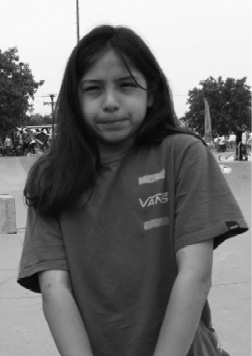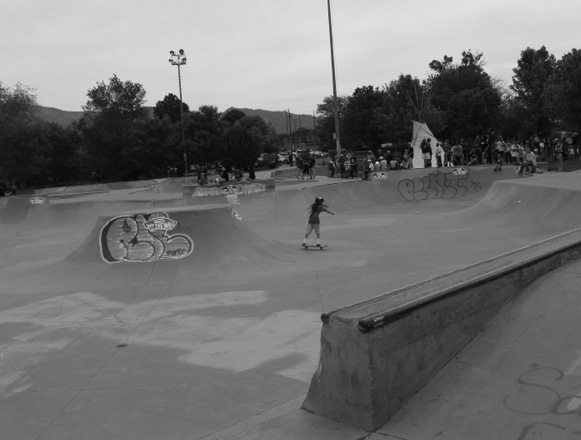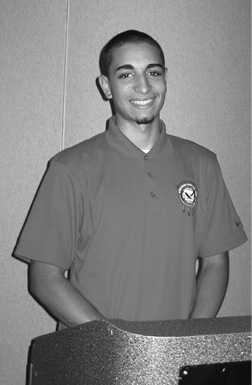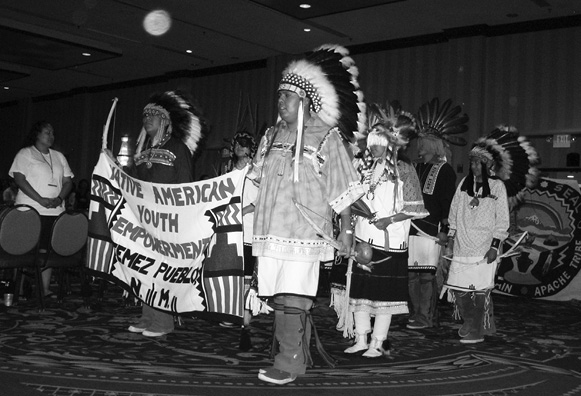Looks Like Daylight (12 page)
Read Looks Like Daylight Online
Authors: Deborah Ellis

Cuay, 12

Indian Nation is fast becoming Skateboard Nation, as more and more Indigenous kids take up the art and skill of skateboarding. Skateboarding is the fastest-growing sport on Native American reservations.
There is a traveling exhibit with the Smithsonian Institution called Ramp It Up
â
Skateboard Culture in Native America. There are Native skateboard teams such as 4-Wheel War Pony. There are also Native-owned skateboard companies like Wounded Knee Skateboards, Apache Skateboards and Full Blood Skates.
Nibwaakaawin is an organization dedicated to supporting the healthy growth of Aboriginal youth through skateboarding. They put on skateboarding clinics and camps, do school talks and are consultants to tribes who want to build skateparks on their reservations.
For the past seven years, they have been hosting the All Nations Skate Jam. Hundreds of young skaters from many tribes come together to compete in front of thousands of spectators.
That's where I met Cuay.
I'm Ojibwe from Mt. Pleasant, Michigan. My mom is from Michigan. My dad is from Kettle Point in Canada. He manages the Soaring Eagle Casino and Resort. My grampa's cousin was shot and killed by the Canadian police. His name was Dudley George. He was protesting our land being taken away so Canada shot him.
My reservation is called Saginaw Chippewa. I'm in seventh grade. My best subject is social studies. I don't always like math.
I learned to drum at school â well, I'm still learning. I started when I was six, so I've been drumming half my life. My school is on the reservation, so it's all Native American kids, which I like, because then our culture is part of every day. We don't have to put it away when the teachers want us to do something else. It's always around us.
My favorite thing to do is skateboarding. I've been doing it for three or four years. I like to go really fast. I was a little scared when I started, but now I'm used to it. The hardest trick I do â and I still haven't quite landed it â is the 540. You have to rotate on your board 540 degrees. I keep working on it. I'll get there.
We've been coming to the skate jam for years. Kids from all over are part of it. Last year we had kids from Manitoba, from Walpole Island, from Washington, all over. The pros come too, to show us things. Tony Alva's been here, and Bill Danforth â lots of pros. We come and stay all day. We eat, drum, listen to music, skate, meet everybody. It's the best.
For the competition today we're broken down into groups in our ages, and then it's beginners, intermediate and like that. I'm in the six to twelve beginners because I've only been at it a few years. We have kids here who are really good, who've been doing it for a very long time.
I'm trying to learn Ojibwe. Our community has only a few elders left who speak it. It's hard. I only know a little bit. I dance too. I do the Fancy War Dance.

Cuay skateboarding
When I do these things, I think about who I am and all the people who did the drumming and the dancing before me.
I'm more Ojibwe than American. The white Americans have wanted to get rid of us for hundreds of years, but we're still here. There used to be a saying, “Kill the Indian to save the man.” Which means to get rid of the Indian part, which they thought was bad. Really what the saying means is, “Kill the Indian to save the white man.” But, like I said, we're still here!
Jeffrey, 18

In 1949 the Hoover Commission outlined a policy of termination, through which it sought to force Native Americans into white society by simply declaring that their tribes no longer existed. The motive was to get Indigenous people off land that mining and energy companies wanted to exploit. From 1953 to 1962, termination was the official policy of the US government
â
109 tribes were told they didn't exist anymore, including the Klamath in Oregon and the Menominee from the Wisconsin area. More than one million acres of Native land was taken from them, and more than 13,000 Native Americans lost all tribal affiliation.
Indigenous peoples have a history of fighting for their rights, in groups such as the All Indian Pueblo Council
â
which formed initially in 1598 and then was renewed in the 1920s
â
and the National Congress of American Indians, which began in 1944. The termination policy galvanized a new era of activism, and the National Indian Youth Council was formed in 1961.
United National Indian Tribal Youth (UNITY) is an organization that brings together Native young people and trains them to be leaders in their local communities and on national issues. It started thirty-five years ago and now has 150 youth councils all over the United States and Canada. Every summer there is a conference with speakers, workshops and renewing of spirit.
I met Jeffrey at the UNITY conference in Minneapolis.
I come from the Watuppa Wampanoag Reservation on Martha's Vineyard, an island off the coast of Massachusetts. Wampanoag means People of the First Light. We're the first to see the sun in the morning. It was my ancestors who greeted the Pilgrims when they landed on Plymouth Rock, and my ancestors helped them survive through the first winter. When you think of Thanksgiving, think of us.
There were thousands of us before the Europeans came. The invaders brought epidemics, and they captured lots of us and turned us into slaves and shipped us to the Caribbean. There's a Wampanoag community in Bermuda today that comes from the slave trade hundreds of years ago.
Now Martha's Vineyard is like a playground for rich and famous people. President Bill Clinton went there for a holiday. So did the Obamas, Reese Witherspoon, all kinds of writers and celebrities. They sail and go shopping and eat in the restaurants.
I've lived on the reservation all my life. My mother is from there. I don't know my biological dad. My stepfather moved in with us when I was six. He works at the post office. My mother just had another baby, so I have a new brother.
On the island the rez is thirty minutes from everything. It's hard for people to move around unless they have a car, so it can seem very isolated.
There's one high school on the island and there was a lot of racism there. You get squashed for being Native. And for not having money. Like I said, some of the families on the island are rich. Not all of them. After all, someone has to do the work for the rich people!
Some of the white adults would be on your side, but a lot of them would cheat you. Like at basketball, the coach would give more playing time to the rich white kids, even if the Indian kids were better players. I'd look down the bench and see all these brown faces. We all knew what was happening.
The rich kids got stuff handed to them. They had nice clothes, but they didn't take care of them. They had expensive cars, all the latest toys. They didn't care.
We had to fight for everything we got.
When I was growing up, I had no real idea what it meant to be Indian. It did not seem like anything special. It felt like a disadvantage.
One of my friends started up a youth council on the reservation a few years ago. I didn't get involved at first because I didn't think it would go anywhere. But she kept on at me to work with her, and because I liked her, I gave it a try. It made me feel a little stronger, a little more hopeful.
And then I went to a UNITY conference in Oklahoma, and my whole world changed. I couldn't believe there were all these young Indians who were proud to be Indian, who knew about their culture, who were strong and spoke up for themselves, sometimes in their original languages!
At this year's conference we have over 1,500 youth from many different tribes and communities. They've come here to plan, to meet others, and to get energized so they can go back to their home communities feeling strong and ready to work.

Procession at the UNITY conference
in Minneapolis
The experience of that first conference transformed me. Seeing so many tribal youth proud to be who they are! So many tribal adults cheering them on, encouraging them, expecting them to be strong and do well, telling them that what they do is important, that the decisions they make can lift up their entire nation.
After I came back from Oklahoma full of stories, my mother was inspired to get more involved in the community too. I was so encouraged! I wanted to carry that feeling with me all the time. She now works as an advisor to the local youth council.
Before I got involved I felt empty, angry and alone. I believed all the negative messages. I couldn't imagine any sort of future for myself. Just more emptiness.
If UNITY hadn't come into my life, I don't even want to think about what my life would be like. I get chills just thinking about it, with some of the stuff I was into. I certainly wouldn't be where I am or what I am today. It's the people of UNITY who tell you to believe in yourself. It's the love, the encouragement. It's the way your life is touched and the way you learn to touch the lives of others. It's also the high expectations that are put on you. You are expected to do well, to challenge yourself and be a good example. It's because of the stakes being so high. The weight of history is on you, but there are lots of people around to help you carry that weight. And if you slip, they are there for you and they get you back on track.
Where I come from, when you leave the rez, no one cares about you. You might as well be invisible.
I went back to my reservation all energized and got really involved with my youth council. I got elected vice president and started learning all I could from older kids and anyone who would teach me. Learning about my culture and history and how to work with others. After two years of being vice president, I got elected president.
I also became a representative from my council to the UNITY conference. Once you become a rep, you get to go to the leadership trainings and meet reps from all over Indian country. You really get to see the work that goes into building an organization. You learn how to learn, how to facilitate others learning and doing. I bring new things back to my community after every meeting.
The conference is busy all the time, every day. There are workshops and meetings, guest speakers and music. On one night there is a cultural show. Youth show off the dances and regalia of their tribe or nation. Another night there's a talent show. All kinds of kids showing all kinds of talent.
The welcome was given by Bea Shawanda, an elder from Manitoulin Island. She told us that UNITY means standing together and keeping distractions at bay, so that we can learn what's really important, that our traditions and culture provide answers for everything. Our mothers and fathers and grandparents and ancestors fought and died so that we could be here.
Grandpa Sky, the elder who started the first UNITY Fire, is here with us too. The fire is the sacred fire that burns through the whole conference. It is set up in the parking lot of this hotel. There's a canopy to keep the elders out of the hot sun and the rain. Anyone can go and sit by the fire and talk or just be. Grandpa Sky was honored today. He is in a wheelchair and he came to the front of the auditorium and a special blanket was put around his shoulders. He told us that what you do from your mind and heart is worth more than any dollar bill that there is. After he spoke, kids lined up to greet him â a long, long line of kids who just wanted to have a moment with this good man.
Native youth are hungry to be connected to something. They can find that connection here and in the traditions of their own communities. Sometimes they have to go looking for it, but as long as they believe it's out there, they'll find it.
We have elders at our conference who were part of the early days of putting UNITY together. I look at them, then I look at the fifteen-year-olds who are here for the first time. I can see that these young kids are going to become strong, powerful leaders for the Indian Nation. It makes me really proud.
Our leaders don't take it easy on us just because we're young. One of the adult leaders on the first day said, “Your grandparents think you're cute. Well, you aren't cute to me. You are leaders. You need to be serious and know that you can make a difference now. You don't have to wait ten or twenty or thirty years. In fact, you can't wait that long. There are kids your age who commit suicide, who have given up on themselves or are strung out on drugs and alcohol. They can't wait any longer for help, and you can't wait any longer to step up.”
He said, “You are the ones who have to embrace Indian youth, that if the youth are lost, then all of us, our history, our culture, our ancestors, all are lost. You are the loss of us or the return of us.”
It's a big responsibility, but it's no bigger than what our ancestors did for us. And what we do, we do for the Native youth who will follow us, seven generations from now.
It's on us now.
